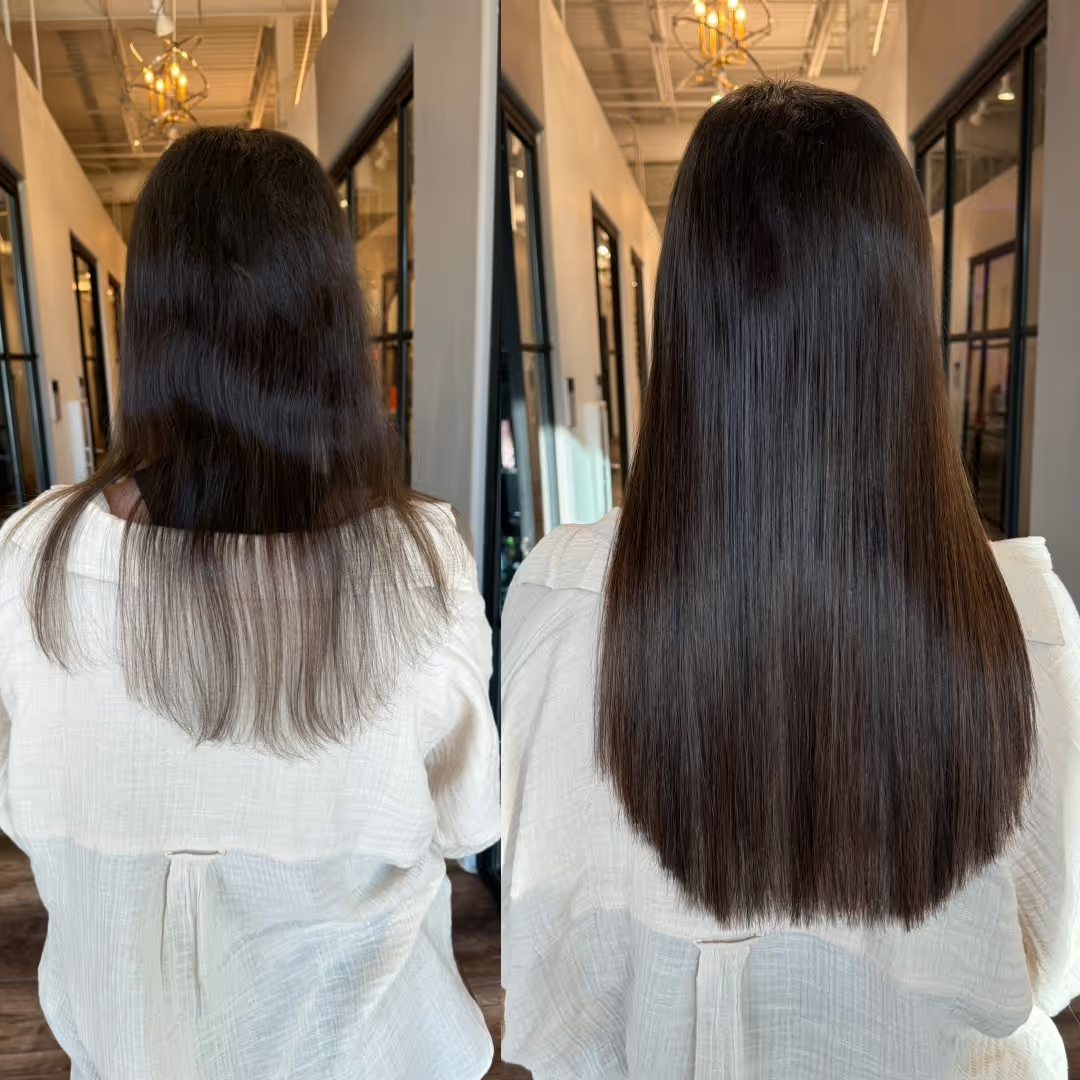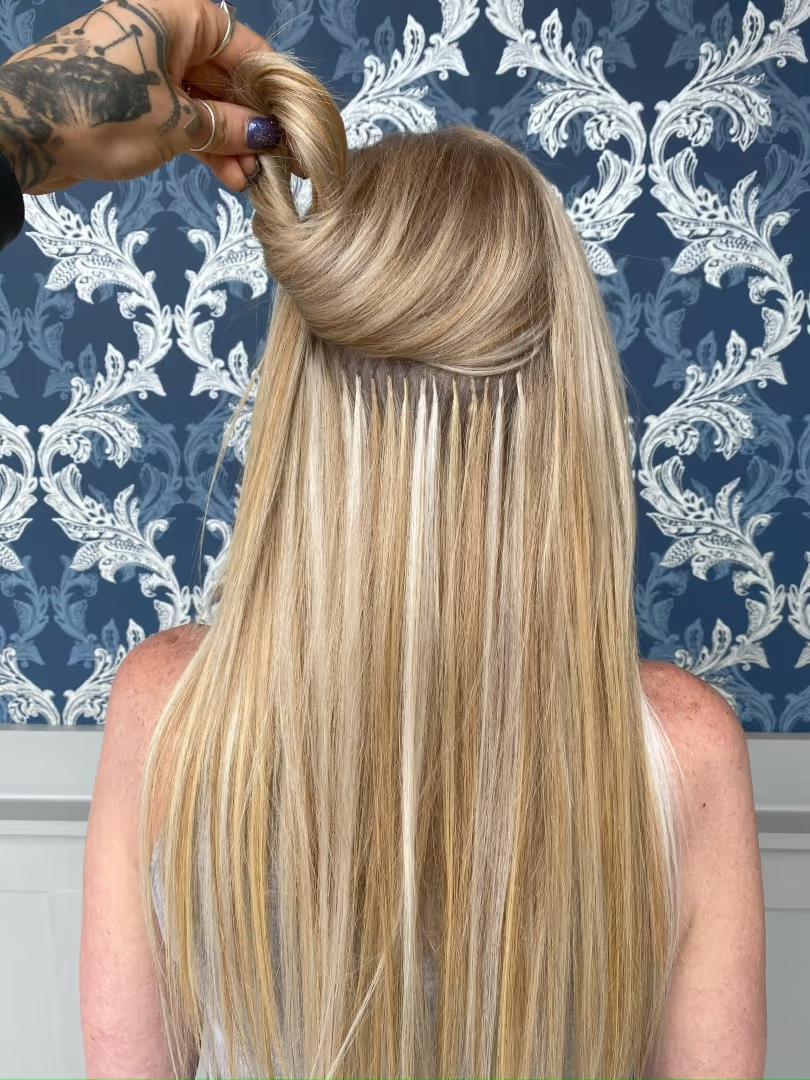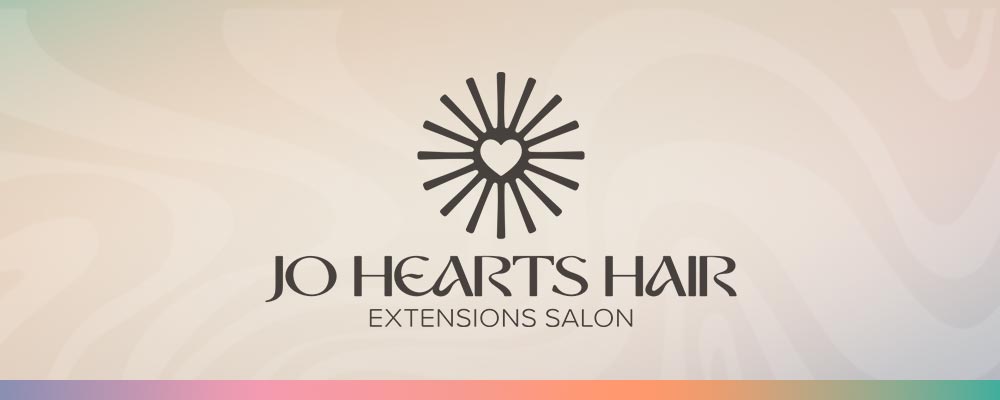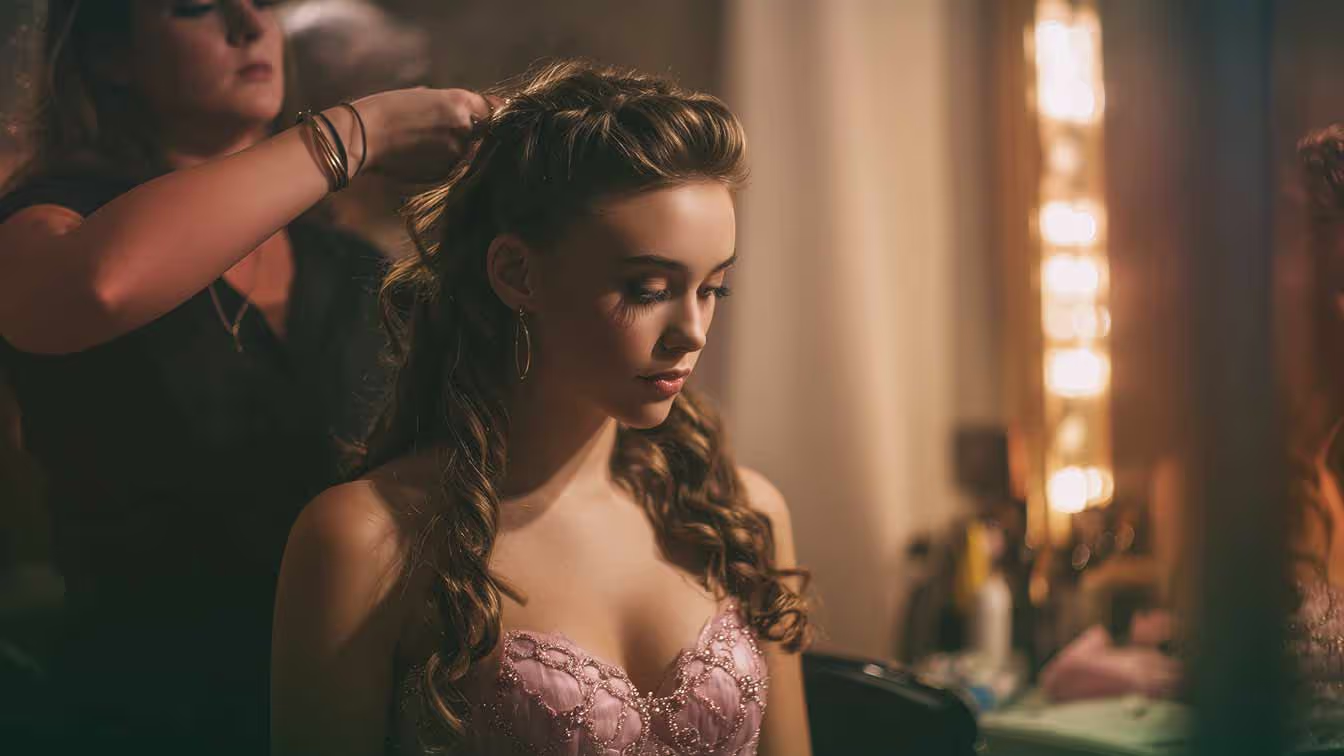Key Takeaways
Why Colorado's Climate Changes Everything About Extension Care
Here's something most salons won't tell you: extensions in Denver are literally not the same as extensions in California or Florida. Our high altitude, brutal dry air, low humidity, and mineral-heavy water create totally different challenges. I've been working with South Denver hair since 2017, and honestly? Understanding our climate is half the battle to keeping extensions looking fresh and healthy.
Colorado's dryness hits extensions hard. Your natural hair gets dehydrated faster. Static becomes a real issue—I've had clients tell me their extensions get frizzy just walking between their car and the office. And hard water? The mineral deposits build up quicker here than anywhere else, making even beautiful extensions look dull after a few weeks if you're not using the right maintenance routine.
What this means practically: you can't just follow generic extension care guides you find online. You need someone who understands the Colorado factor. The hair extension care in Colorado is genuinely different. We use specific hydrating treatments, recommend hard-water filters for your shower, and adjust everything from product recommendations to maintenance scheduling around our climate.
I always tell clients: good extensions in a humid climate can get away with less maintenance. Here? You're working with the climate, not against it. That's where knowing your stylist matters. Someone who gets Colorado gets that your extensions aren't just about application—they're about survival in our environment.
This is why I customize my entire approach based on where you live. Living in Lone Tree? Parker? Highlands Ranch? Those communities all have similar climate challenges, and that shapes everything from which methods I recommend to how often you'll need maintenance.

K-Tip Fusion Extensions: The Most Natural-Looking Option
K-tip fusion extensions using Great Lengths extensions are basically magic if you understand how they work. Each individual strand gets bonded with a keratin tip to your natural hair. We're talking potentially 100+ individual bonds for a full head, which means each strand moves independently—exactly like your real hair would.
Here's what I love about fusions: the movement is insane. Because every strand is separate, there's zero tension. No pulling, no discomfort. They feel like your hair. People don't notice them because they look and move exactly like extensions should—invisible. I had a client from the DTC tell me her coworkers swore she just "finally grew out her hair naturally."
Installation takes 4-6 hours though—I'm not gonna lie. You're sitting in my chair for a serious chunk of time. But here's why it's worth it: they last 3-5 months before needing repositioning. And reposition appointments? They're quick. About 30-45 minutes, and you're done. The bonds stay intact; we're just moving them up as your hair grows.
Cost-wise, plan on $1,500-$2,500+ for installation depending on how much hair you need and if we're doing color customization. Then add repositioning appointments every 6-8 weeks at $200-400 each. First-year investment is real, but you're getting 12 months of genuinely flawless hair.
The downside? Removal has to be done right. We use professional acetone and proper technique. Trying to DIY removal or going to someone untrained? That's how you damage your hair. The bond needs to be dissolved correctly. That's why coming back to someone experienced matters.
Who should choose fusions? Anyone who wants the most natural result. Anyone with fine or delicate hair—this is my specialty because the individual bonds mean zero bulk, zero weight. Anyone who wants to wear their hair in styles without worrying about visible tape or braids showing.

Tape-In Extensions: The Comfortable Workhorse
Tape-in extensions using brands like HairTalk are honestly the perfect middle ground. You get semi-permanent extensions without the extreme time commitment of fusions. Medical-grade adhesive sandwiches your natural hair between two pre-taped pieces of extension hair. Sounds simple? It is. And it works really well.
Installation takes 1-2 hours max. The tape lays completely flat against your scalp, so they're basically invisible in ponytails and updos. This is huge for people who wear their hair up—nobody can tell. The weightless feeling is legit. Clients tell me they forget they're wearing extensions within a day or two.
Here's the maintenance reality: every 6-8 weeks, you come back for a "move-up" appointment. As your hair grows, the tape moves down with it. We reposition the tape higher on your head, maintaining that invisible placement. These appointments run $150-300 depending on how many tapes need moving. Yeah, it requires regular salon visits. But if you're already going in for color or other services, it's kinda convenient to bundle everything.
The reusable aspect is actually solid. We can reuse the extension hair 2-4 times if the tape removal is done properly. So that $800-1,500 initial investment gets stretched a bit. Some clients end up wearing the same hair for 6-12 months, just repositioning.
One thing I always explain: tape-ins aren't set-and-forget. But they're also not high-maintenance compared to some other methods. They're the sweet spot if you want semi-permanent with manageable upkeep.
Who loves tape-ins? Professional women (especially around the DTC) who need polished hair but don't have hours for installation. People with medium to fine hair who want to avoid the weight of sew-ins. Anyone who travels frequently—they hold up great through flights and different water.
Tape-in extensions work beautifully on Colorado hair because the flat application means less exposure to our dry air. The contact area is minimal, which helps with durability.

Sew-In Weft Extensions: Maximum Volume for Active Lifestyles
Sew-in weft extensions are basically the bold choice. We braid your natural hair into cornrows, then hand-sew extension wefts into those braids using needle and thread. It sounds intense because it is. Installation takes 2-3 hours, and the result? Serious, undeniable volume.
This method is incredible if you have medium to thick natural hair and want maximum fullness. The wefts are thick, they add real density, and once they're in? They're in. You can swim, work out, sleep on them rough, do whatever. They're secure in a way that's honestly hard to beat.
Maintenance every 6-10 weeks involves re-tightening the braids and potentially re-sewing sections. It's not complicated, but it's consistent. Cost-wise, installation is $600-1,200, which is actually the most affordable semi-permanent option upfront. Move-ups run $150-250.
But here's the honest truth I tell every client: sew-ins aren't ideal for fine or delicate hair. The tension from the braids can eventually cause damage if your hair is fragile. If you have thin hair, this isn't your method. The weight alone feels uncomfortable, and the pulling at the scalp is real. I've seen clients with fine hair try sew-ins and regret it.
Who crushes with sew-ins? Active moms in Highlands Ranch who hit CrossFit multiple times a week. Athletes. Anyone who doesn't want to worry about tape slipping in chlorine. People with naturally thick hair who want no-fuss volume.
Colorado weather actually doesn't cause specific issues with sew-ins the way it does with some methods. The braids and wefts hold up well in our climate. Just keep the braids clean and dry between appointments, and you're good.

Clip-In Extensions: The No-Commitment Game Change
Clip-in extensions are the hidden gem nobody talks about enough. They're wefts with pressure-sensitive clips that snap into your natural hair—you can put them in and take them out whenever. Daily wear? Absolutely. Special events only? Perfect. Testing before committing to semi-permanent? This is literally exactly what they're for.
Installation is literally 5-10 minutes. You section your hair, clip them in at the roots, and boom—instant length and volume. No appointment needed. No professional required. You do it yourself at home. And here's the beautiful part: absolutely zero damage to your natural hair. You're not gluing, bonding, or braiding anything. You're literally clipping.
Cost is super accessible: $300-600 for a full set of quality human hair. And these last 6-12 months with proper care because you're not wearing them constantly. The attachment points don't get worn out the same way they do with semi-permanent methods.
Customization is insane too. I can color-match them to your exact undertones. Cut them to your specific length. Add custom highlights within the extensions if you want dimension without lightening your natural hair. Some clients come in and we create totally different looks—some days sleek straight, some days beachy waves, some days voluminous curls. All with different clip-in styles.
The honest downside: if you want to wear them daily, you do need to put them in every morning. Some people love that—they get to style their hair fresh each day. Others find it tedious. It's really about your lifestyle and how much that matters to you.
Who loves clip-ins? Brides testing before committing to extensions. People who want to transition to semi-permanent but aren't sure. Anyone wanting flexible, zero-damage options. Professional women who want to switch up their look without commitment.
For Colorado hair, clip-ins are actually incredible because you can remove them whenever our climate is being extra harsh. Heat wave turning everything frizzy? Take them off. Dry spell making everything staticky? Remove them for a bit. Total control.

Real Client Stories: How Different Clients Found Their Perfect Method
I've been doing extensions long enough that I've seen every situation. These real stories (with details changed for privacy) show how the right method makes all the difference.
Sarah from DTC: She's a consultant, meetings all day, networking events constantly. Natural hair was fine, shoulder-length, and she wanted polished length without looking overdone. We went with tape-in extensions in a custom caramel blonde that matched her natural balayage. Total investment was $950 for installation plus $200 every 7 weeks for move-ups. She says it's the best money she's spent because her hair looks professional without screaming "extensions."
Jen from Highlands Ranch: CrossFit 4 times a week, three kids, zero time for fussing. Natural hair is medium-thick, which gave us options. K-tip fusion extensions were perfect. She can wash, blow dry, and go. No tape worrying about pool water. Zero daily styling needed. Investment was $1,800 initial plus repositioning every 8 weeks. She told me it's literally the most selfish money she's spent on herself, and she's not even sorry.
Emma getting married: Fine hair, terrified of damage, 4 months until her wedding. We started with clip-in extensions two months out so she could test them during engagement events and see if she liked wearing them. She did, so we transitioned to K-tips one month before the wedding so she could wear them overnight before her big day. Total was $400 (clips) + $1,600 (fusion) = $2,000. Her wedding photos are genuinely stunning. She says the investment was 100% worth the confidence boost.
These stories all have one thing in common: the right method matched their actual lifestyle, not what sounds fanciest. That's the whole point. Extensions should make your life easier, not more complicated.

The Colorado Hair Health Guarantee: Why Expertise Actually Matters
Here's something I'm genuinely passionate about: extensions shouldn't be one-size-fits-all. Most salons don't care. They apply whatever method you ask for and send you out the door. That's not how I work at Jo Hearts Hair.
My consultation process is literally an assessment, not a sales pitch. I look at your hair health first. We talk about your lifestyle, your styling preferences, your realistic goals. Sometimes—and I'm serious about this—the recommendation is clip-ins because that's actually the best choice for your situation. Not because they're the cheapest or most profitable. Because they're what makes sense for you.
Color matching is something I obsess over. Bad color kills everything. I'm checking your undertones in natural light, considering if you want warm, cool, or neutral tones, and sometimes even custom-blending extensions to match exactly. This isn't extra; this is essential.
Colorado-specific care is built into how I work. Every client gets a dry climate care protocol tailored to our environment: specific hydrating products, hard-water shower filters I recommend, static-fighting techniques, everything. This isn't generic extension care. This is Colorado extension care.
Maintenance appointments aren't just "tape more stuff on." I'm checking your natural hair health, assessing how the extensions are wearing, talking about what's working and what isn't, and adjusting if we need to. If something's not right, we fix it. That's the difference between getting extensions and having someone actually care about your results.
And here's what I promise: if extensions aren't right for you, I'll tell you that. I'd rather send someone away than put extensions in their hair when they're not ready or when another solution is better. That's the kind of stylist I want to be.

What Extensions Actually Cost (And Why the Price Matters)
Let's be super transparent about cost because I hate when salons are vague about pricing.
The hair itself costs money. Premium human hair—the kind I use—costs $300-1,000+ depending on length, density, and color customization. Synthetic hair is cheaper but looks cheap and falls apart within weeks. Not worth it.
Application is a service. You're paying for certification, years of experience, and time. A proper K-tip installation takes 5-6 hours. That's not overhead. That's actual skilled labor. Tape-in takes less time but still requires precision. Sew-in requires braiding skill and sewing ability. These aren't just "putting stuff on your head."
Maintenance is ongoing. Every 6-8 weeks, plan on $150-400 per appointment depending on your method. Over a year, that adds up. But it's also the difference between extensions looking fresh and looking terrible.
Here's a real first-year breakdown (K-tip example):
- Initial application: $1,800
- Repositioning appointments (3 total at $300 each): $900
- Home care products (hydrating masks, hard water filter, sulfate-free products): $200
- Total: ~$2,900
That's about $240/month for 12 months of genuinely transformed hair. When you think about it that way—a subscription to amazing hair—it shifts perspective. You're not spending $2,900 on something. You're investing in your appearance and confidence for an entire year.
Is that expensive? Compared to what? Compared to going to the salon every six weeks for color? Compared to buying new clothes regularly? Compared to skincare? Extensions are actually a solid investment in your appearance.
Start with a consultation (which is free, no pressure) and let's talk real numbers for your specific situation.

How to Choose Your Method: The Real Decision Framework
Okay, so you've learned about all four methods. Now how do you actually decide?
If you have fine or delicate hair: This is literally my specialty. You need either K-tips or tape-ins. Sew-ins are too heavy and will eventually cause tension damage. The beauty of K-tips is that each individual strand means zero bulk, zero weight. Tape-ins are also weightless. Both work beautifully on fragile hair when applied correctly.
If you're very active: Sew-ins or K-tips. Tape-ins can slip in chlorine if you're in pools constantly. Clip-ins obviously aren't ideal if you need them permanently. But sew-ins and fusions stay secure through literally anything. I've had clients in intense fitness routines with both methods, and they hold up great.
If you want the easiest daily experience: K-tips. They feel like your hair, move like your hair, and require zero special care beyond normal washing and conditioning. You wake up with gorgeous hair. No application time, no special removal routine, no daily styling needed.
If you want maximum flexibility: Clip-ins, hands down. Take them off whenever. Style them differently. Switch things up. Zero commitment.
If you're on a tighter budget initially: Clip-ins to start, then invest in semi-permanent if you love extensions. Sew-ins also have the lowest upfront cost, but again—they require the right hair type.
If you want to test before committing: Clip-ins absolutely. Wear them to events, see how you feel about longer hair, figure out what style actually makes you confident. Then transition to semi-permanent if you're ready.
The thing is? There's no wrong choice. There's just the right choice for your specific hair, lifestyle, and goals. That's why the consultation matters so much. We talk through all this together, and I help you figure out what actually makes sense for your life.
FAQ: Your Extension Questions Answered
Will extensions damage my natural hair?
Not if they're applied and maintained correctly. Damage happens when extensions are applied too tightly, left in too long without maintenance, removed improperly, or your natural hair is already compromised. With proper technique, regular maintenance appointments, and professional removal, your hair stays healthy. That's literally my priority—hair health comes first, always.
Can I wash and style my extensions like normal hair?
Yes, but with a specific routine. You'll wash less frequently (1-2 times per week instead of daily), use sulfate-free products, condition from mid-length down, and avoid sleeping on wet hair. It's not complicated; it's just different. I give every client detailed care instructions based on their specific method.
How often do I need maintenance?
It depends on your method. K-tips and tape-ins need repositioning every 6-8 weeks. Sew-ins need re-tightening every 6-10 weeks. Clip-ins? Whenever you want to take them out—zero maintenance required. The consistency matters because it prevents damage and keeps everything looking fresh.
What if I hate my extensions after getting them?
You shouldn't. A solid consultation prevents this. We talk through exactly what you're getting, what it'll feel like, what the timeline looks like, and what the maintenance commitment is. But if something isn't working? We troubleshoot. Sometimes it's a simple adjustment. Sometimes we realize a different method would be better. I'm not trying to trap you into something forever.
Do extensions work on fine or thinning hair?
Absolutely—this is my specialty. The key is choosing the right method. K-tips and tape-ins work beautifully on fine hair. Sew-ins would be too heavy and could cause tension damage. With fine hair, we're strategic about placement, we use proper tension during application, and we schedule regular maintenance so nothing sits too long and causes problems.
How long do extensions actually last?
The hair itself lasts years with proper care. The attachment point (bond, tape, braid) lasts weeks to months depending on method. You're not replacing the whole thing constantly—you're maintaining the application. I've had clients wear the same hair for a year, just repositioning or re-taping as their natural hair grows. That's why the upfront investment makes sense.
Ready for Your Perfect Extensions?
Remember, everyone's hair journey is completely unique! What works perfectly for your bestie might need tweaking for your specific hair, lifestyle, and goals. And honestly? That's completely normal.
The best first step? Come in for a free consultation. No pressure, no sales pitch. We'll talk through your hair, your lifestyle, your goals, and what's actually possible for you—not some generic version of you.
Located at: 9227 East Lincoln Ave, Suite #111, Lone Tree, CO 80124 (right off Lincoln Ave, free parking, private suite setting)
Hours: Tuesday-Saturday, flexible scheduling including evening appointments
How to Book:
- Schedule online through the website
- Text/call for same-day or next-week appointments
- Consultations are completely free with zero pressure
Follow @joheartshair on Instagram for daily transformation inspo, behind-the-scenes looks at the application process, and proof that extensions can look ridiculously natural! ✨
Here's to hair that actually makes you feel like yourself—just better,
XOXO,
Jo 💕




